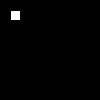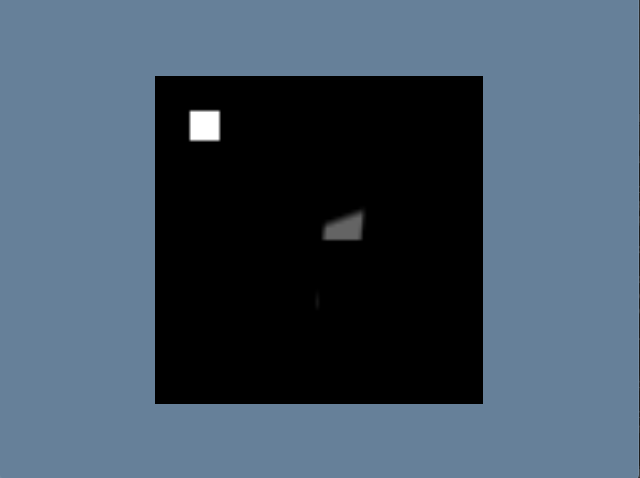Watch Registration#
Synopsis#
Watch the iterations of a registration using VTK.
Results#

fixed.png#

moving.png#

Output In VTK Window#
Output:
Optimizer stop condition: RegularStepGradientDescentOptimizer: Maximum number of iterations (1000) exceeded.
Final Transform: AffineTransform (0x7f9129d00120)
RTTI typeinfo: itk::AffineTransform<double, 2u>
Reference Count: 4
Modified Time: 215110
Debug: Off
Object Name:
Observers:
none
Matrix:
0.789218 0.062097
0.139299 0.37936
Offset: [7.3411, 26.2747]
Center: [49.5, 49.5]
Translation: [-0.0188083, 2.44832]
Inverse:
1.30477 -0.213577
-0.479108 2.71444
Singular: 0
Final Parameters: [0.7892180100803599, 0.06209699937125816, 0.13929938284463836, 0.37935986885403217, -0.018808339095318795, 2.448323274873905]
Result =
Iterations = 1000
Metric value = -0.00195192
Numb. Samples = 500
Code#
C++#
#include "itkImageRegistrationMethod.h"
#include "itkAffineTransform.h"
#include "itkMattesMutualInformationImageToImageMetric.h"
#include "itkRegularStepGradientDescentOptimizer.h"
#include "itkNormalizeImageFilter.h"
#include "itkDiscreteGaussianImageFilter.h"
#include "itkResampleImageFilter.h"
#include "itkCheckerBoardImageFilter.h"
#include "itkFlipImageFilter.h"
#include "itkImageFileReader.h"
#include "itkImageToVTKImageFilter.h"
#include "itkCenteredTransformInitializer.h"
#include "vtkVersion.h"
#include "vtkSmartPointer.h"
#include "vtkRenderWindow.h"
#include "vtkRenderer.h"
#include "vtkInteractorStyleImage.h"
#include "vtkRenderWindowInteractor.h"
#include "vtkImageActor.h"
#include "vtkImageMapper3D.h"
constexpr unsigned int Dimension = 2;
using PixelType = unsigned char;
using InputImageType = itk::Image<PixelType, Dimension>;
using OutputImageType = itk::Image<unsigned char, Dimension>;
// Command observer to visualize the evolution of the registration process.
//
#include "itkCommand.h"
template <typename TImage>
class IterationUpdate : public itk::Command
{
public:
using Self = IterationUpdate;
using Superclass = itk::Command;
using Pointer = itk::SmartPointer<Self>;
itkNewMacro(Self);
protected:
IterationUpdate() = default;
public:
using InternalImageType = itk::Image<float, 2>;
using OptimizerType = itk::RegularStepGradientDescentOptimizer;
using OptimizerPointer = const OptimizerType *;
using ResampleFilterType = itk::ResampleImageFilter<TImage, TImage>;
using TransformType = itk::AffineTransform<double, 2>;
using ConnectorType = itk::ImageToVTKImageFilter<TImage>;
using FilterType = itk::FlipImageFilter<TImage>;
void
Execute(itk::Object * caller, const itk::EventObject & event) override
{
Execute((const itk::Object *)caller, event);
}
void
Execute(const itk::Object * object, const itk::EventObject & event) override
{
auto optimizer = static_cast<OptimizerPointer>(object);
if (!(itk::IterationEvent().CheckEvent(&event)))
{
return;
}
m_Transform->SetParameters(optimizer->GetCurrentPosition());
m_Filter->Update();
m_Connector->SetInput(m_Filter->GetOutput());
m_Connector->Update();
#if VTK_MAJOR_VERSION <= 5
m_ImageActor->SetInput(m_Connector->GetOutput());
#else
m_Connector->Update();
m_ImageActor->GetMapper()->SetInputData(m_Connector->GetOutput());
#endif
m_RenderWindow->Render();
}
void
SetTransform(TransformType::Pointer & transform)
{
m_Transform = transform;
}
void
SetFilter(typename FilterType::Pointer & filter)
{
m_Filter = filter;
}
void
SetConnector(typename ConnectorType::Pointer & connector)
{
m_Connector = connector;
}
void
SetImageActor(vtkImageActor * actor)
{
m_ImageActor = actor;
}
void
SetRenderWindow(vtkRenderWindow * renderWindow)
{
m_RenderWindow = renderWindow;
}
TransformType::Pointer m_Transform;
typename FilterType::Pointer m_Filter;
typename ConnectorType::Pointer m_Connector;
vtkImageActor * m_ImageActor;
vtkRenderWindow * m_RenderWindow;
};
int
main(int argc, char * argv[])
{
auto fixedImage = InputImageType::New();
auto movingImage = InputImageType::New();
if (argc > 2)
{
fixedImage = itk::ReadImage<InputImageType>(argv[1]);
movingImage = itk::ReadImage<InputImageType>(argv[2]);
}
else
{
std::cout << "Usage: " << argv[0] << " fixedImage movingImage" << std::endl;
return EXIT_FAILURE;
}
// Use floats internally
using InternalImageType = itk::Image<float, Dimension>;
// Normalize the images
using NormalizeFilterType = itk::NormalizeImageFilter<InputImageType, InternalImageType>;
auto fixedNormalizer = NormalizeFilterType::New();
auto movingNormalizer = NormalizeFilterType::New();
fixedNormalizer->SetInput(fixedImage);
movingNormalizer->SetInput(movingImage);
// Smooth the normalized images
using GaussianFilterType = itk::DiscreteGaussianImageFilter<InternalImageType, InternalImageType>;
auto fixedSmoother = GaussianFilterType::New();
auto movingSmoother = GaussianFilterType::New();
fixedSmoother->SetVariance(3.0);
fixedSmoother->SetInput(fixedNormalizer->GetOutput());
movingSmoother->SetVariance(3.0);
movingSmoother->SetInput(movingNormalizer->GetOutput());
// Set up registration
using TransformType = itk::AffineTransform<double, Dimension>;
using OptimizerType = itk::RegularStepGradientDescentOptimizer;
using InterpolatorType = itk::LinearInterpolateImageFunction<InternalImageType, double>;
using MetricType = itk::MattesMutualInformationImageToImageMetric<InternalImageType, InternalImageType>;
using RegistrationType = itk::ImageRegistrationMethod<InternalImageType, InternalImageType>;
using InitializerType = itk::CenteredTransformInitializer<TransformType, InputImageType, InputImageType>;
auto initializer = InitializerType::New();
auto transform = TransformType::New();
auto optimizer = OptimizerType::New();
auto interpolator = InterpolatorType::New();
auto registration = RegistrationType::New();
// Set up the registration framework
initializer->SetFixedImage(fixedImage);
initializer->SetMovingImage(movingImage);
initializer->SetTransform(transform);
transform->SetIdentity();
initializer->GeometryOn();
initializer->InitializeTransform();
registration->SetOptimizer(optimizer);
registration->SetTransform(transform);
registration->SetInterpolator(interpolator);
auto metric = MetricType::New();
registration->SetMetric(metric);
registration->SetFixedImage(fixedSmoother->GetOutput());
registration->SetMovingImage(movingSmoother->GetOutput());
// Update to get the size of the region
fixedNormalizer->Update();
InputImageType::RegionType fixedImageRegion = fixedNormalizer->GetOutput()->GetBufferedRegion();
registration->SetFixedImageRegion(fixedImageRegion);
using ParametersType = RegistrationType::ParametersType;
ParametersType initialParameters(transform->GetNumberOfParameters());
// rotation matrix (identity)
initialParameters[0] = 1.0; // R(0,0)
initialParameters[1] = 0.0; // R(0,1)
initialParameters[2] = 0.0; // R(1,0)
initialParameters[3] = 1.0; // R(1,1)
// translation vector
initialParameters[4] = 0.0;
initialParameters[5] = 0.0;
registration->SetInitialTransformParameters(initialParameters);
const unsigned int numberOfPixels = fixedImageRegion.GetNumberOfPixels();
const auto numberOfSamples = static_cast<unsigned int>(numberOfPixels * 0.05);
metric->SetNumberOfHistogramBins(26);
metric->SetNumberOfSpatialSamples(numberOfSamples);
optimizer->MinimizeOn();
optimizer->SetMaximumStepLength(0.500);
optimizer->SetMinimumStepLength(0.001);
optimizer->SetNumberOfIterations(1000);
const unsigned int numberOfParameters = transform->GetNumberOfParameters();
using OptimizerScalesType = OptimizerType::ScalesType;
OptimizerScalesType optimizerScales(numberOfParameters);
double translationScale = 1.0 / 1000.0;
optimizerScales[0] = 1.0;
optimizerScales[1] = 1.0;
optimizerScales[2] = 1.0;
optimizerScales[3] = 1.0;
optimizerScales[4] = translationScale;
optimizerScales[5] = translationScale;
optimizer->SetScales(optimizerScales);
auto finalTransform = TransformType::New();
finalTransform->SetParameters(initialParameters);
finalTransform->SetFixedParameters(transform->GetFixedParameters());
using ResampleFilterType = itk::ResampleImageFilter<InputImageType, InputImageType>;
auto resample = ResampleFilterType::New();
resample->SetTransform(finalTransform);
resample->SetInput(movingImage);
resample->SetSize(fixedImage->GetLargestPossibleRegion().GetSize());
resample->SetOutputOrigin(fixedImage->GetOrigin());
resample->SetOutputSpacing(fixedImage->GetSpacing());
resample->SetOutputDirection(fixedImage->GetDirection());
resample->SetDefaultPixelValue(100);
resample->Update();
// Set up the visualization pipeline
using CheckerBoardFilterType = itk::CheckerBoardImageFilter<InputImageType>;
auto checkerboard = CheckerBoardFilterType::New();
CheckerBoardFilterType::PatternArrayType pattern;
pattern[0] = 4;
pattern[1] = 4;
checkerboard->SetCheckerPattern(pattern);
checkerboard->SetInput1(fixedImage);
checkerboard->SetInput2(resample->GetOutput());
using FlipFilterType = itk::FlipImageFilter<InputImageType>;
auto flip = FlipFilterType::New();
bool flipAxes[3] = { false, true, false };
flip->SetFlipAxes(flipAxes);
flip->SetInput(checkerboard->GetOutput());
flip->Update();
// VTK visualization pipeline
using ConnectorType = itk::ImageToVTKImageFilter<InputImageType>;
auto connector = ConnectorType::New();
connector->SetInput(flip->GetOutput());
vtkSmartPointer<vtkImageActor> actor = vtkSmartPointer<vtkImageActor>::New();
#if VTK_MAJOR_VERSION <= 5
actor->SetInput(connector->GetOutput());
#else
connector->Update();
actor->GetMapper()->SetInputData(connector->GetOutput());
#endif
vtkSmartPointer<vtkRenderWindow> renderWindow = vtkSmartPointer<vtkRenderWindow>::New();
vtkSmartPointer<vtkRenderer> renderer = vtkSmartPointer<vtkRenderer>::New();
renderer->SetBackground(.4, .5, .6);
renderer->AddActor(actor);
renderWindow->SetSize(640, 480);
;
renderWindow->AddRenderer(renderer);
renderWindow->Render();
// Set up the iteration event observer
IterationUpdate<InputImageType>::Pointer observer = IterationUpdate<InputImageType>::New();
optimizer->AddObserver(itk::IterationEvent(), observer);
observer->SetTransform(finalTransform);
observer->SetFilter(flip);
observer->SetConnector(connector);
observer->SetImageActor(actor);
observer->SetRenderWindow(renderWindow);
try
{
registration->Update();
std::cout << "Optimizer stop condition: " << registration->GetOptimizer()->GetStopConditionDescription()
<< std::endl;
}
catch (const itk::ExceptionObject & err)
{
std::cout << "ExceptionObject caught !" << std::endl;
std::cout << err << std::endl;
return EXIT_FAILURE;
}
std::cout << "Final Transform: " << finalTransform << std::endl;
ParametersType finalParameters = registration->GetLastTransformParameters();
std::cout << "Final Parameters: " << finalParameters << std::endl;
unsigned int numberOfIterations = optimizer->GetCurrentIteration();
double bestValue = optimizer->GetValue();
// Print out results
std::cout << std::endl;
std::cout << "Result = " << std::endl;
std::cout << " Iterations = " << numberOfIterations << std::endl;
std::cout << " Metric value = " << bestValue << std::endl;
std::cout << " Numb. Samples = " << numberOfSamples << std::endl;
// Interact with the image
vtkSmartPointer<vtkRenderWindowInteractor> interactor = vtkSmartPointer<vtkRenderWindowInteractor>::New();
vtkSmartPointer<vtkInteractorStyleImage> style = vtkSmartPointer<vtkInteractorStyleImage>::New();
interactor->SetInteractorStyle(style);
interactor->SetRenderWindow(renderWindow);
interactor->Start();
return EXIT_SUCCESS;
}
Classes demonstrated#
-
template<typename TFixedImage, typename TMovingImage>
class MattesMutualInformationImageToImageMetric : public itk::ImageToImageMetric<TFixedImage, TMovingImage> Computes the mutual information between two images to be registered using the method of Mattes et al.
MattesMutualInformationImageToImageMetric computes the mutual information between a fixed and moving image to be registered.
This class is templated over the FixedImage type and the MovingImage type.
The fixed and moving images are set via methods SetFixedImage() and SetMovingImage(). This metric makes use of user specified Transform and Interpolator. The Transform is used to map points from the fixed image to the moving image domain. The Interpolator is used to evaluate the image intensity at user specified geometric points in the moving image. The Transform and Interpolator are set via methods SetTransform() and SetInterpolator().
If a BSplineInterpolationFunction is used, this class obtain image derivatives from the BSpline interpolator. Otherwise, image derivatives are computed using central differencing.
The method
GetValue() computes of the mutual information while method GetValueAndDerivative() computes both the mutual information and its derivatives with respect to the transform parameters.- Warning
This metric assumes that the moving image has already been connected to the interpolator outside of this class.
The calculations are based on the method of Mattes et al [1,2] where the probability density distribution are estimated using Parzen histograms. Since the fixed image PDF does not contribute to the derivatives, it does not need to be smooth. Hence, a zero order (box car) BSpline kernel is used for the fixed image intensity PDF. On the other hand, to ensure smoothness a third order BSpline kernel is used for the moving image intensity PDF.
On Initialize(), the FixedImage is uniformly sampled within the FixedImageRegion. The number of samples used can be set via SetNumberOfSpatialSamples(). Typically, the number of spatial samples used should increase with the image size.
The option UseAllPixelOn() disables the random sampling and uses all the pixels of the FixedImageRegion in order to estimate the joint intensity PDF.
During each call of GetValue(), GetDerivatives(), GetValueAndDerivatives(), marginal and joint intensity PDF’s values are estimated at discrete position or bins. The number of bins used can be set via SetNumberOfHistogramBins(). To handle data with arbitrary magnitude and dynamic range, the image intensity is scale such that any contribution to the histogram will fall into a valid bin.
One the PDF’s have been constructed, the mutual information is obtained by doubling summing over the discrete PDF values.
Notes:
This class returns the negative mutual information value.
References: [1] “Nonrigid multimodality image registration” D. Mattes, D. R. Haynor, H. Vesselle, T. Lewellen and W. Eubank Medical Imaging 2001: Image
Processing, 2001, pp. 1609-1620. [2] “PET-CT Image Registration in the Chest Using Free-form Deformations” D. Mattes, D. R. Haynor, H. Vesselle, T. Lewellen and W. Eubank IEEE Transactions in Medical Imaging. Vol.22, No.1, January 2003. pp.120-128. [3] “Optimization of Mutual Information for MultiResolution Image
Registration” P. Thevenaz and M. Unser IEEE Transactions in
Image Processing, 9(12) December 2000.- ITK Sphinx Examples:
